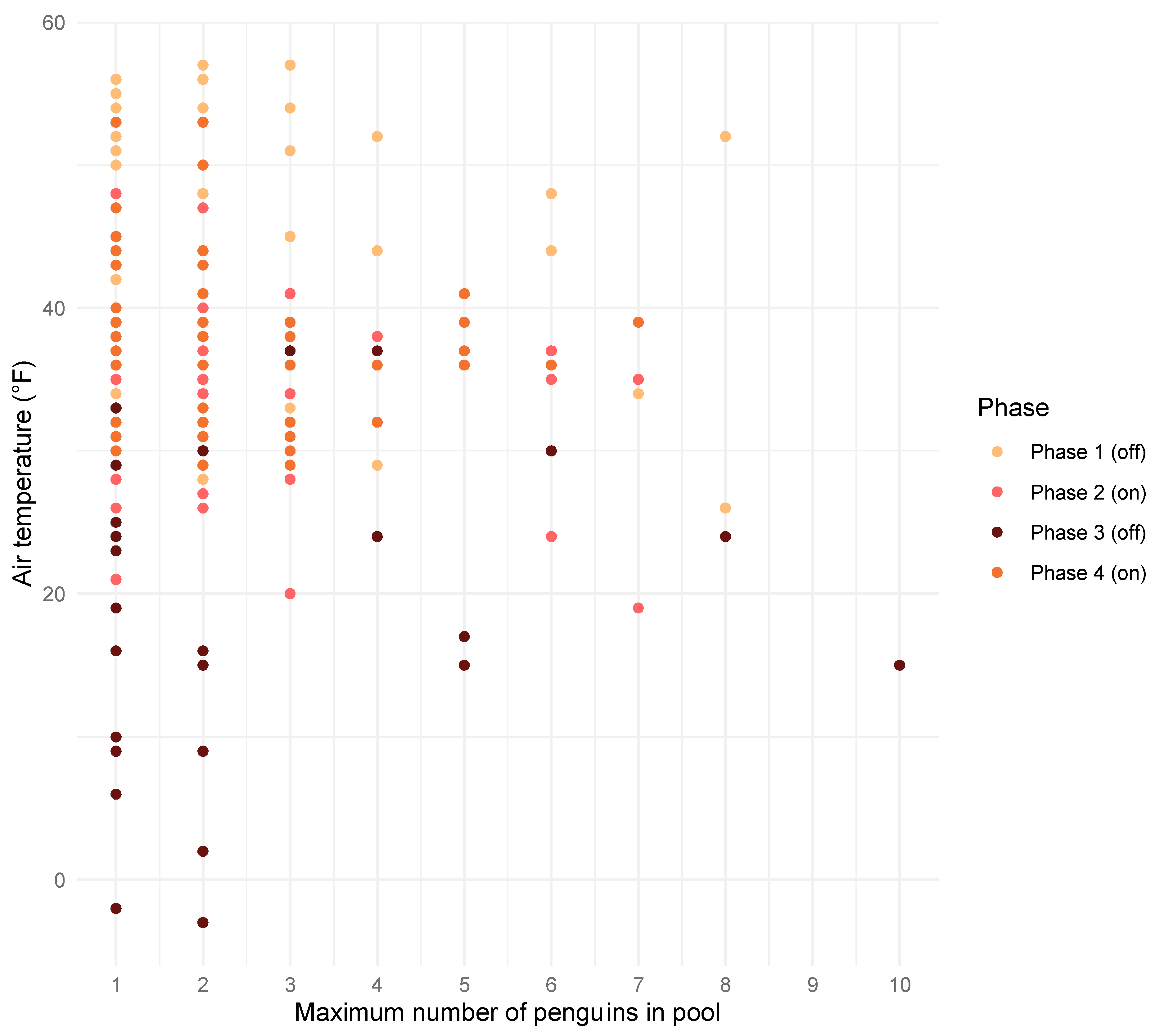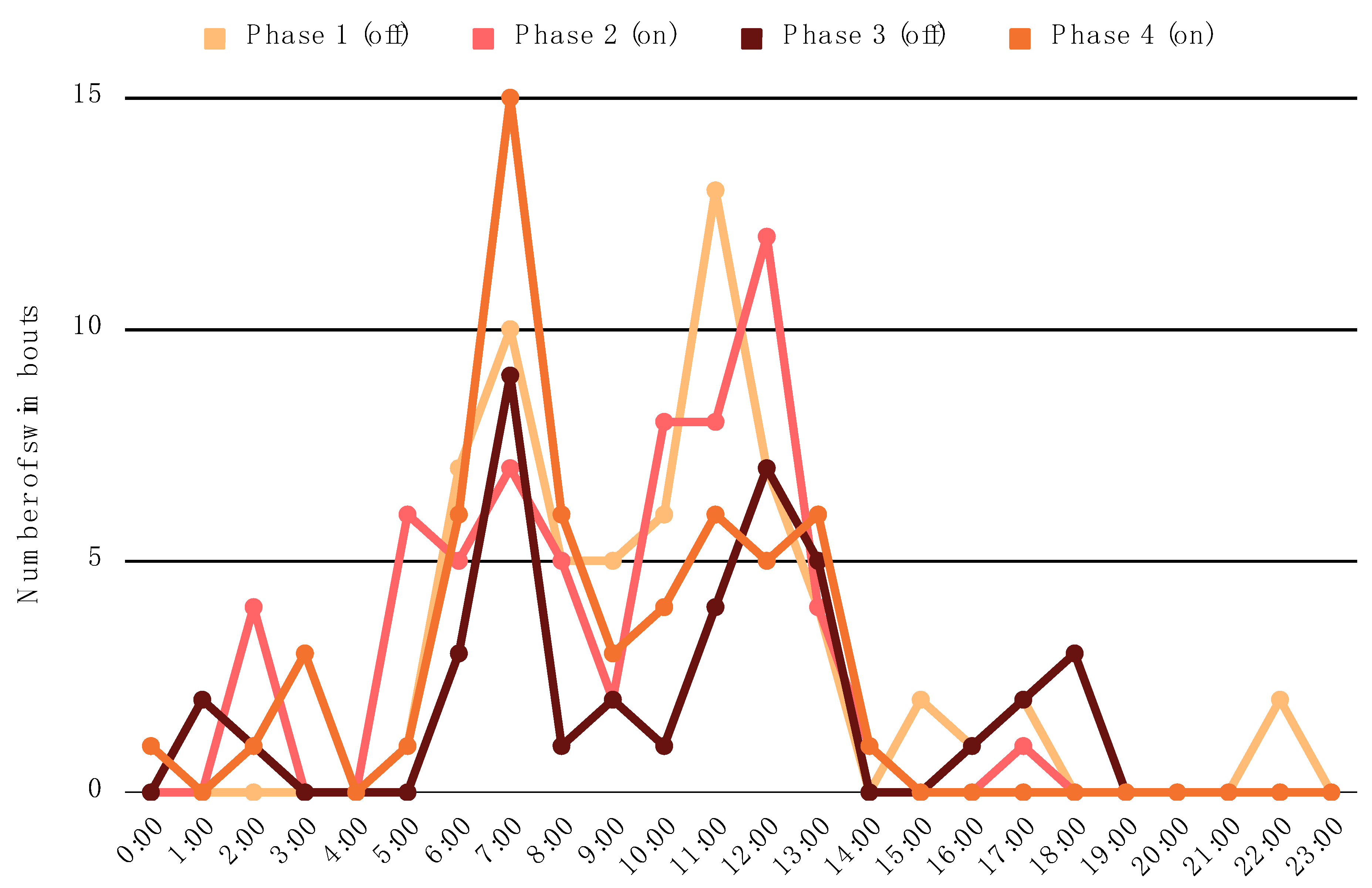The Impacts of a Commercial Bubble Curtain on Zoo-Housed African Penguin (Spheniscus demersus) Swimming Behavior
Abstract
:1. Introduction
2. Materials and Methods
2.1. Subjects and Habitat
2.2. Study Design
2.3. Behavioral Data Collection
2.4. Data Analysis
3. Results
3.1. Swimming Time
3.2. Maximum Number of Penguins in the Pool
3.3. Effect of Time of Day
3.4. Nighttime Swimming
4. Discussion
5. Conclusions
Supplementary Materials
Author Contributions
Funding
Institutional Review Board Statement
Data Availability Statement
Acknowledgments
Conflicts of Interest
References
- Tremblay, Y.; Cherel, Y. Geographic variation in the foraging behaviour, diet and chick growth of rockhopper penguins. Mar. Ecol. Prog. Ser. 2003, 251, 279–297. [Google Scholar] [CrossRef]
- Yoda, K.; Naito, Y.; Sato, K.; Takahashi, A.; Nishikawa, J.; Ropert-Coudert, Y.; Kurita, M.; Le Maho, Y. A new technique for monitoring the behaviour of free-ranging Adelie penguins. J. Exp. Biol. 2001, 204, 685–690. [Google Scholar] [CrossRef]
- Kirkwood, R.; Robertson, G. The foraging ecology of female emperor penguins in winter. Ecol. Monogr. 1997, 67, 155–176. [Google Scholar] [CrossRef]
- Kooyman, G.L.; Cherel, Y.; Maho, Y.L.; Croxall, J.P.; Thorson, P.H.; Ridoux, V.; Kooyman, C.A. Diving behavior and energetics during foraging cycles in king penguins. Ecol. Monogr. 1992, 62, 143–163. [Google Scholar] [CrossRef]
- Fernandez, E.J.; Myers, M.; Hawkes, N.C. The effects of live feeding on swimming activity and exhibit use in zoo Humboldt penguins (Spheniscus humboldti). J. Zool. Bot. Gard. 2021, 2, 88–100. [Google Scholar] [CrossRef]
- Razal, C.; Miller, L. The effect of different types of environmental enrichment on Humboldt penguin (Spheniscus humboldti) behaviour. J. Zoo Aquar. Res. 2021, 9, 281–286. [Google Scholar]
- Clements, J.; Sanchez, J.N. Creation and validation of a novel body condition scoring method for the Magellanic penguin (Spheniscus magellanicus) in the zoo setting. Zoo Biol. 2015, 34, 538–546. [Google Scholar] [CrossRef]
- Figel, T.; Coyne, S.P.; Martin, K. Sex and Age Differences in Activity Budgets in a Population of Captive African Penguins (Spheniscus demersus). J. Appl. Anim. Welf. Sci. 2021, 26, 438–446. [Google Scholar] [CrossRef]
- Woods, J.M.; Eyer, A.; Miller, L.J. Bird Welfare in Zoos and Aquariums: General Insights across Industries. J. Zool. Bot. Gard. 2022, 3, 198–222. [Google Scholar] [CrossRef]
- Erlacher-Reid, C.; Dunn, J.L.; Camp, T.; Macha, L.; Mazzaro, L.; Tuttle, A.D. Evaluation of potential variables contributing to the development and duration of plantar lesions in a population of aquarium-maintained African penguins (Spheniscus demersus). Zoo Biol. 2012, 31, 291–305. [Google Scholar] [CrossRef]
- Fernandez, E.J.; Kinley, R.C.; Timberlake, W. Training penguins to interact with enrichment devices for lasting effects. Zoo Biol. 2019, 38, 481–489. [Google Scholar] [CrossRef] [PubMed]
- Edes, A.N.; Baskir, E.; Bauman, K.L.; Chandrasekharan, N.; Macek, M.; Tieber, A. Effects of crowd size, composition, and noise level on pool use in a mixed-species penguin colony. Anim. Behav. Cogn. 2021, 8, 507–520. [Google Scholar] [CrossRef]
- Zhang, J.; Quirke, T.; Wu, S.; Li, S.; Butler, F. Impact of weather changes and human visitation on the behavior and activity level of captive Humboldt penguins. Pak. J. Zool. 2021, 53, 591. [Google Scholar] [CrossRef]
- Saiyed, S.T.; Hopper, L.M.; Cronin, K.A. Evaluating the behavior and temperament of African penguins in a non-contact animal encounter program. Animals 2019, 9, 326. [Google Scholar] [CrossRef]
- R Core Team. R: A Language and Environment for Statistical Computing; R Foundation for Statistical Computing: Vienna, Austria, 2021; Available online: https://www.R-project.org/ (accessed on 10 August 2023).
- Zeileis, A.; Hothorn, T. Diagnostic Checking in Regression Relationships. R News 2002, 2, 7–10. Available online: https://CRAN.R-project.org/doc/Rnews/ (accessed on 28 March 2023).
- Bates, D.; Sarkar, D.; Bates, M.D.; Matrix, L. The lme4 Package; R Foundation for Statistical Computing: Vienna, Austria, 2007; Volume 2, p. 74. [Google Scholar]
- Brando, S.; Buchanan-Smith, H.M. The 24/7 approach to promoting optimal welfare for captive wild animals. Behav. Process. 2018, 156, 83–95. [Google Scholar] [CrossRef]
- Hirskyj-Douglas, I.; Webber, S. Reflecting on methods in animal computer interaction: Novelty effect and habituation. In Proceedings of the Eight International Conference on Animal-Computer Interaction, Bloomington, IN, USA, 8–11 November 2021; pp. 1–11. [Google Scholar]
- Anderson, C.; Arun, A.S.; Jensen, P. Habituation to environmental enrichment in captive sloth bears—Effect on stereotypies. Zoo Biol. 2010, 29, 705–714. [Google Scholar] [CrossRef]
- Marshall, A.R.; Deere, N.J.; Little, H.A.; Snipp, R.; Goulder, J.; Mayer-Clarke, S. Husbandry and enclosure influences on penguin behavior and conservation breeding. Zoo Biol. 2016, 35, 385–397. [Google Scholar] [CrossRef]
- Blay, N.; Côté, I.M. Optimal conditions for breeding of captive Humboldt penguins (Spheniscus humboldti): A survey of British zoos. Zoo Biol. Publ. Affil. Am. Zoo Aquar. Assoc. 2001, 20, 545–555. [Google Scholar] [CrossRef]
- Wilson, R.P.; Grémillet, D.A.V.I.D. Body temperatures of free-living African penguins (Spheniscus demersus) and bank cormorants (Phalacrocorax neglectus). J. Exp. Biol. 1996, 199, 2215–2223. [Google Scholar] [CrossRef]
- Finch, K.; Sach, F.; Fitzpatrick, M.; Masters, N.; Rowden, L.J. Longitudinal improvements in zoo-housed elephant welfare: A case study at zsl whipsnade zoo. Animals 2020, 10, 2029. [Google Scholar] [CrossRef] [PubMed]
- Finch, K.; Sach, F.; Fitzpatrick, M.; Rowden, L.J. Insights into activity of zoo housed Asian elephants (Elephas maximus) during periods of limited staff and visitor presence, a focus on resting behaviour. J. Zool. Bot. Gard. 2021, 2, 101–114. [Google Scholar] [CrossRef]
- Ramont, M.; Leahy, M.; Cronin, K.A. The welfare of domestic goats (Capra hircus) in a zoo-based animal-visitor interaction program. Anim. Behav. Cogn. 2021, 8, 493–506. [Google Scholar] [CrossRef]
- Ramont, M.; Leahy, M.; Cronin, K.A. Domestic animal welfare at the zoo: The impact of an animal visitor interaction program on chickens. Anim. Behav. Cogn. 2021, 8, 1–14. [Google Scholar] [CrossRef]
- Polgár, Z.; Wood, L.; Haskell, M.J. Individual differences in zoo-housed squirrel monkeys’ (Saimiri sciureus) reactions to visitors, research participation, and personality ratings. Am. J. Primatol. 2017, 79, e22639. [Google Scholar] [CrossRef]
- Eskelinen, H.C.; Winship, K.A.; Borger-Turner, J.L. Sex, age, and individual differences in bottlenose dolphins (Tursiops truncatus) in response to environmental enrichment. Anim. Behav. Cogn. 2015, 2, 241–253. [Google Scholar] [CrossRef]
- Shepherdson, D.; Lewis, K.D.; Carlstead, K.; Bauman, J.; Perrin, N. Individual and environmental factors associated with stereotypic behavior and fecal glucocorticoid metabolite levels in zoo housed polar bears. Appl. Anim. Behav. Sci. 2013, 147, 268–277. [Google Scholar] [CrossRef]
- Stoinski, T.S.; Jaicks, H.F.; Drayton, L.A. Visitor effects on the behavior of captive western lowland gorillas: The importance of individual differences in examining welfare. Zoo Biol. 2012, 31, 586–599. [Google Scholar] [CrossRef]
- ZIMS Species Holdings. Species360 Zoological Information Management System. 2023. Available online: http://zims.species360.org/ (accessed on 28 June 2023).


| Phase | Bubble Curtain Condition | Duration | Dates |
|---|---|---|---|
| Phase 1: Week 1–2 | off all hours | 15 days | 16 November–30 November |
| Phase 2: Week 3–4 | on 7:00–15:00 | 14 days | 1 December–14 December |
| Phase 3: Week 5–6 | off all hours | 19 days | 15 December–2 January |
| Phase 4: Week 7–8 | on 7:00–15:00 | 15 days | 3 January–17 January |
| Phase | Bubble Curtain | Average Swim Bout Duration (minutes) | Count Swim Bouts | Total Time Swimming (minutes) | Average Air Temperature (°F) | Average Pool Temperature (°F) |
|---|---|---|---|---|---|---|
| Phase 1: Week 1–2 | Off | 5 ± 6 | 65 | 360 | 43 ± 9 | 51 ± 2 |
| Phase 2: Week 3–4 | On | 12 ± 19 | 63 | 572 | 38 ± 6 | 54 ± 4 |
| Phase 3: Week 5–6 | Off | 9 ± 16 | 42 | 414 | 23 ± 11 | 49 ± 4 |
| Phase 4: Week 7–8 | On | 4 ± 5 | 58 | 260 | 37 ± 6 | 53 ± 6 |
| Response Variable | Model | AIC | df |
|---|---|---|---|
| Swimming time | GLM (Swimtime~Bubble curtain + AirTemp) | 3048.76 | 3 |
| GLM (Swimtime~Bubble curtain + PoolTemp) | 3055.04 | 3 | |
| GLM (SwimTime~Bubble curtain) | 3059.01 | 2 | |
| GLM (SwimTime~AirTemp) | 3129.66 | 2 | |
| GLM (SwimTime~PoolTemp) | 3127.06 | 2 | |
| Maximum number of penguins in pool | GLM (Max~Bubble curtain + AirTemp) | 821.36 | 3 |
| GLM (Max~Bubble curtain + PoolTemp) | 823.55 | 3 | |
| GLM (Max~Bubble curtain) | 821.61 | 2 | |
| GLM (Max~AirTemp) | 819.36 | 2 | |
| GLM (Max~PoolTemp) | 821.58 | 2 |
| Air Temperature (°F) | Count Swim Bouts | Total Time Swimming (minutes) | Average Swim Bout Duration (minutes) |
|---|---|---|---|
| −10–0 | 2 | 2 | 1 ± 0 |
| 1–10 | 5 | 26 | 5 ± 3 |
| 11–20 | 9 | 119 | 13 ± 19 |
| 21–30 | 45 | 397 | 9 ± 13 |
| 31–40 | 110 | 742 | 7 ± 15 |
| 41–50 | 35 | 226 | 7 ± 7 |
| 51–60 | 22 | 94 | 4 ± 6 |
Disclaimer/Publisher’s Note: The statements, opinions and data contained in all publications are solely those of the individual author(s) and contributor(s) and not of MDPI and/or the editor(s). MDPI and/or the editor(s) disclaim responsibility for any injury to people or property resulting from any ideas, methods, instructions or products referred to in the content. |
© 2023 by the authors. Licensee MDPI, Basel, Switzerland. This article is an open access article distributed under the terms and conditions of the Creative Commons Attribution (CC BY) license (https://creativecommons.org/licenses/by/4.0/).
Share and Cite
O’Brien, S.L.; Cronin, K.A. The Impacts of a Commercial Bubble Curtain on Zoo-Housed African Penguin (Spheniscus demersus) Swimming Behavior. J. Zool. Bot. Gard. 2023, 4, 567-577. https://doi.org/10.3390/jzbg4030040
O’Brien SL, Cronin KA. The Impacts of a Commercial Bubble Curtain on Zoo-Housed African Penguin (Spheniscus demersus) Swimming Behavior. Journal of Zoological and Botanical Gardens. 2023; 4(3):567-577. https://doi.org/10.3390/jzbg4030040
Chicago/Turabian StyleO’Brien, Shannon L., and Katherine A. Cronin. 2023. "The Impacts of a Commercial Bubble Curtain on Zoo-Housed African Penguin (Spheniscus demersus) Swimming Behavior" Journal of Zoological and Botanical Gardens 4, no. 3: 567-577. https://doi.org/10.3390/jzbg4030040
APA StyleO’Brien, S. L., & Cronin, K. A. (2023). The Impacts of a Commercial Bubble Curtain on Zoo-Housed African Penguin (Spheniscus demersus) Swimming Behavior. Journal of Zoological and Botanical Gardens, 4(3), 567-577. https://doi.org/10.3390/jzbg4030040







